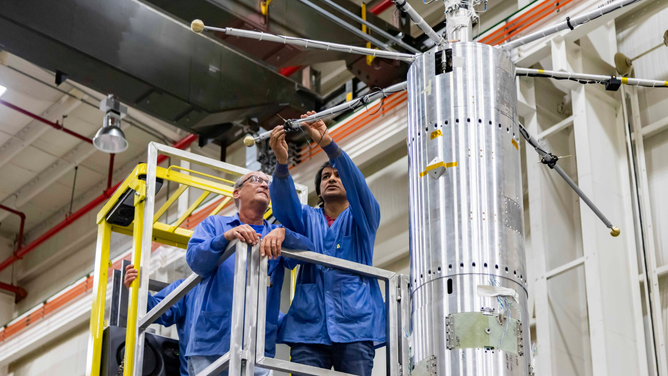NASA to launch a series of rockets into eclipse’s shadow
During the 2017 total solar eclipse, the space agency said scientists detected atmospheric changes. The Atmospheric Perturbations around the Eclipse Path mission or APEP will study the ionosphere.
'Ring of Fire' solar eclipse builds anticipation for total eclipse in 2024
The Southwest is expected to get the best view of Saturday's annular solar eclipse and it's building excitement for the total eclipse in April. Debra Ross of the Rochester Solar Eclipse Task Force joined FOX Weather to discuss more.
WHITE SANDS MISSILE RANGE, New Mexico – When the annular eclipse passes over North America Saturday, the sights of the Moon and the sun will not be the only features flying high above Earth - NASA is planning to launch a series of rockets to study the impacts the celestial event will have on the atmosphere.
The space agency said three rockets will launch during the mission from the White Sands Missile Range in New Mexico.
The rockets will be tasked with taking observations of the sudden drop in sunlight in the upper atmosphere.
The Atmospheric Perturbations around the Eclipse Path mission, or what is commonly referred to as the APEP, is expected to find changes in electrons and atoms, that lead to sudden temperature and density changes.
"If you think of the ionosphere as a pond with some gentle ripples on it, the eclipse is like a motorboat that suddenly rips through the water," Aroh Barjatya, a professor of engineering physics at Embry-Riddle Aeronautical University, said in a statement. "It creates a wake immediately underneath and behind it, and then the water level momentarily goes up as it rushes back in."
5 OF THE MOST IMPORTANT ROCKET LAUNCH IN THE HISTORY OF SPACEFLIGHT

Mechanical technicians examine sensitive sensors ahead of launch.
(NASA)
Scientists said previous eclipses, such as the event in 2017, led instruments to discover atmospheric changes well outside of the total solar eclipse’s path.
If the mission is successful, NASA said it’ll be the first-time simultaneous measurements will have been taken in the ionosphere during an eclipse.
"Rockets are the best way to look at the vertical dimension at the smallest possible spatial scales," Barjatya stated. "They can wait to launch at just the right moment and explore the lower altitudes where satellites can’t fly."
The rockets won’t be the only instruments being used to monitor effects caused by the annular solar eclipse, researchers in the Southwest are planning to release high-altitude balloons to measure changes in the weather.
SEE HOW MUCH OF THE PARTIAL SOLAR ECLIPSE WILL BE VISIBLE IN YOUR CITY
Instruments used during the event are expected to be recovered and reused during the total solar eclipse that will travel from Texas to Maine on April 8, 2024.
To find out when the eclipse will be partially visible in your community, visit NASA’s 2023 Eclipse Explorer map.
